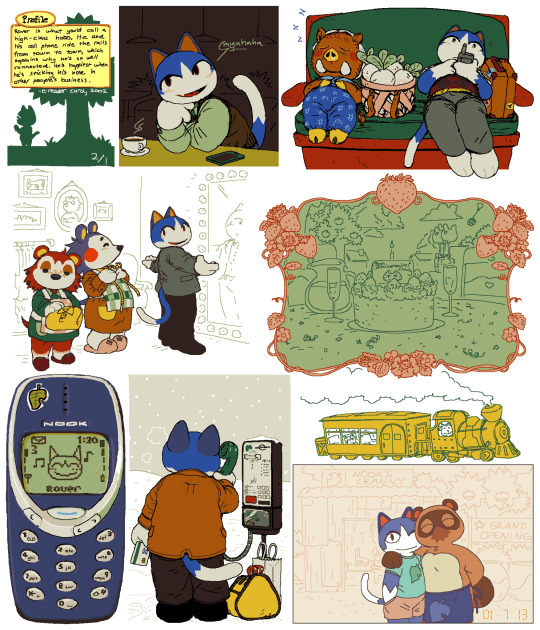Photo






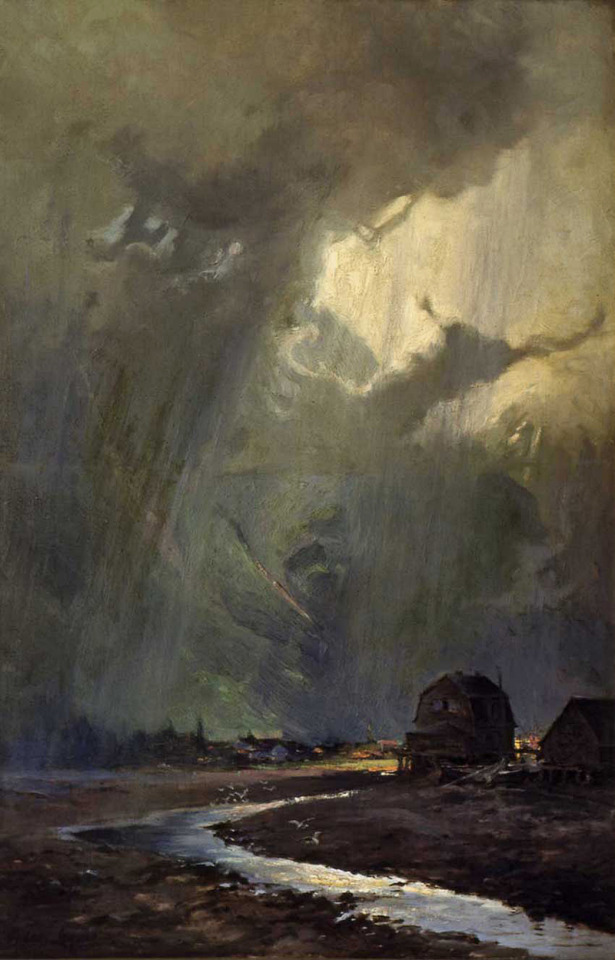
Sydney Mortimer Laurence - Alaska and the Northern Light in nocturnal paintings.
1K notes
·
View notes
Text
Pocahontas Was a Mistake, and Here's Why! (Lindsay Ellis, 2017)
Or, cultural appropriation, representation and the importance of language.
youtube
So Disney has been, for a while, on a bit of a long haul endeavor to diversify its repertoire of characters. Whether it be because of an earnest desire for positive social impact, or simply for the cynical race to put their hands in every culture's pockets, this is besides the point. The fact is, over the past 25 years, the storytelling at the mouse house has often been interested in tapping into different cultures and telling stories from their perspective.
The degree of success to which this has been achieved is... inconsistent. It's no secret that this push coincided, for better and for worse, with several big shakeup in the company structure and production pipeline, shuffling between studio heads like there's no tomorrow, refocusing their animation methodology, fully embracing CG and tossing all their light tables down the garbage disposal, et cetera. This has meant a lot of fumbled bags in terms of their projects, which often shows in their muddled final product, displayed pretty ironically by the reoccurring trend of choosing to portray a story with characters of color, only to turn them into a small marketable raceless inhuman creature of some kind for 70% of the duration of the movie they're supposed to star in (frogs, bears, llamas, blue blob spirit things, face painted ghosts/skeletons, to an extent red pandas, among others).
However, one of their more recent endeavors, Moana, is a pretty clear standout in terms on how it showcases a heavily culture-dependent storyline: she is a chief's daughter, descended from seafaring voyagers, who found their way across the pacific in a fashion never conceived before or after. This story cannot work without Moana, without her setting, without her culture. This, however did not come from thin air. Many have pointed out, as does Ellis, this movie has much to thank its predecessors for, with special regards to Pocahontas, of all films.
To say Pocahontas was received negatively is a bit of an understatement. It was conceived within the studio as an artful love story, Titanic-esque, a straight shot at best picture, only saved for the best of the best. The end result, however, landed in theaters with a thud, only picked up by lambasting reviews which just could not seem to give the film any sort of a break. Boring, pretentious, incredibly insensitive, obvious in its desire for cheap marketing ploys, this movie is one of few often credited for being a major cause for the 00s slump that came after the golden Renaissance, which it also is credited for killing. Tanking the careers of involved activists, hard pivoting the company away from drama-based movies for decades, it was kind of the flop of a generation.
This, though, did not give Disney the lesson one might think it did. As the essay points out, the obvious answer for Disney after being panned for poorly characterizing indigenous cultures would have been to, well, avoid the fire by avoiding the cabin. However, they, somewhat thankfully, for some reason decided to take the more nuanced and less corporately safe approach of simply getting better at how they portray these stories, centering the characters whose cultures they are choosing to depict, and not just centering it on the perceived white western viewer.
Ellis, a media student and writer of her own, emphasizes something which I find to be incredibly important. Any sort of borrowing of aspects of a culture, by someone from a different culture, is, by definition, cultural appropriation. This is simply what this term means. Vitriolic online spaces have singlehandedly taken this piece of very neutral, dry english major jargon and turned it into a pejorative that signifies a breach of power, an imbalance, or a form of co-opted membership, which, is just not what this term means. It is very important to respect this, as simply using it as a means of debasement is the perfect way to flatten a very important and complex set of discussions, which, to my knowledge, most people seem very eager to have.
From Lilo, to Tiana, to Miguel, to Ariel, these are all pieces of work entirely based on cultural appropriation. Walt Disney was not Hawaiian, just as much as he was not Danish. Is there a difference in the effect that occurs depending on the level of cultural, historical colonial power of one of the groups over the other? Yes, there very much is! This, however, is not the appropriate terminology to be used (and neither is the attempted binary opposite of cultural appreciation, by the by), and it is important to recognize why this effect occurs, and how to target it and aim to mend it over time, but this cannot be effectively achieved by way of trying to paint the conversation with the widest brush possible.
For all the grief that can be found in the efforts of Disney to grasp into any culture they can find to try to sell it back to its members, I truly believe the work being done in terms of achieved representation is incredibly important. From cousins who no longer have Dora as their only relatable face, to friends and siblings who grew up learning Colors of the Wind in many languages and instruments, the reason we have these discussions should always be with the intent of achieving improvement in the media we want to see, and to respect it, treat its creation with respect, and care for those who finally can se themselves reflected on the cartoon. We're all in cartoon school, after all.
Thank you for everything Kendall, you're a fantastic teacher, I hope we get the pleasure to have you again. Happy holidays!
0 notes
Text
Scary Godmother (Mainframe, Ezekiel Norton/Jill Thompson, 2003)
So, we've arrived at the end of history. The millennium has turned, decades are hard to abbreviate now and the industry has been turned upside down. Disney has gone through a revival that is now failing, they bought a computer graphics company that's outperforming its main studio and don't really know what to do about it, and are only really holding it together because of not having much competition. All the other animation houses are either on a massive downturn or completely defunct, with the exception of newcomer DreamWorks, which is essentially UPA but with more celebrity power attached.
This bumps us into the current trend: new dimension! Computers have gotten beefy. They can now fully map out the space between simulated points REAL good, meaning they can generate sculpted figures, and if you're real nifty, move them around in fun ways. This is a big groundshaker, the likes of which animation hadn't ever really seen before (with the closest to it being the rise of rotoscoping, which was only outdone by the immediate and much better remembered fall of rotoscoping). Suddenly everyone with a good enough computer could (emphasis on COULD) technically create a full motion picture with complex characters, deep camera action and technically precise shots; without needing to have become a fully fledged fine artists before being any good at it.
And the film I'll be getting into today is a great example of that! A bit behind on the spooky season,
Scary Godmother: Halloween Spooktacular!
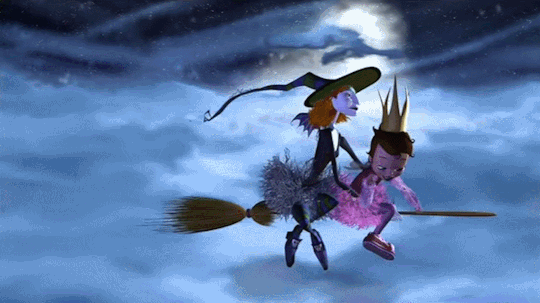
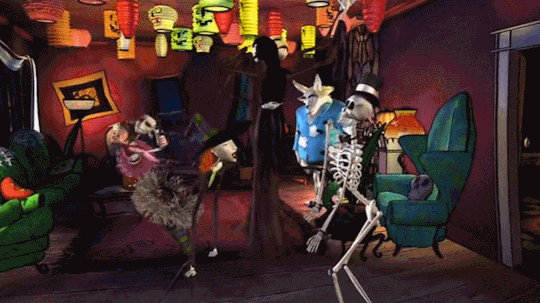

A bona fide 3D holiday special, Scary Godmother hits the big screen for the first time in this fun cult classic. It's a simple story, main character Hannah is out trick or treating, and gets dared by her mean cousin Jimmy to explore a dark house. She gets locked in it, only to find the Godmother looking for her to get her Halloween party started. Hosting for all her friends, she introduces Hannah to all the new monstrous faces attending, and they have a thrilling scare of a time partying, in which Hannah learns not to judge a book by its cover, and Justin learns not to a be a prickly little nerd.
From the description alone, you wouldnt think much of this short little movie. At firsti didn't get it either, even after watching it for the first time. But upon further revisits, I've come to see why it means so much to so many people, and it all comes back to its atmosphere. Scary Godmother really nails capital S Spooky with pinpoint precision. I rarely get to see such an accurate depiction of what the Halloween holidays feel like for kids as this movie depicts, and that's speaking as someone who lives and breathes for the months of the holiday.
It also has quite the interesting grassroots production history as well. Mainframe's first foray into feature animation, the structure of this film called for more hardware beef than the studio had ever worked with, putting a noticeable strain on the budget. This was also bolstered by the animation team allegedly doubling in size mid-production, which led to the heavy involvement of Jill Thompson (author of the original children's books the special is adapting) being a huge boon for the project, functioning as a sort of creative director for the team.
Overall, I'm happy to say I'm a convert for team Scary Godmother, and it has become a comfortable yearly tradition in early October movie nights.
References:
Scary Godmother is a Halloween Nostalgiafest - Vulture
Scary Godmother: Halloween Spooktacular - Wikipedia
Mainframe Studios - Wikipedia
Scary Godmother (Series) - The Scary Godmother Wiki
0 notes
Text
The Pink Panther Show (Hanna-Barbera/David H. DePatie, Friz Freleng; 1969-1979)
The 1970s were quite a pivotal time for the industry. With Disney in one of its biggest historical slumps and television becoming more standard, it was time for bigger studios to rise to the occasion and populate the at-home viewing landscape with as many cartoons as they could muster. This led to a barage of properties that all launched very quickly, as it was kind of a space race to see who could become "the Disney of TV".
After leaving the dying MGM animation division and being burnt out from Warner Brothers, William Hana and Joseph Barbera would once again find themselves as the main providers of animated entertainment as their production house only got more popular over the years. With dozens of projects running, it seemed they were leading the charge for claiming the aforementioned title to themselves. Additionally, the public had not too long ago had their minds blown by the heart found in UPA's productions, even when these were mostly created with two hotdogs and a prayer for a budget. These factors all created a bit of a perfect storm for Hanna-Barbera productions, making quick, cheap-but-memorable entertainment and holding their place as a household name. This leads us to one of their most popular creations, and the subject of today's analysis:



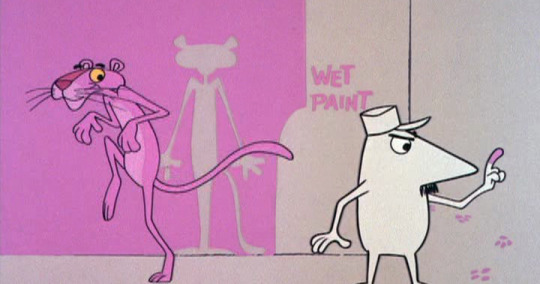
Hijinks. That's all that goes on here.
This show was kind of a one-of-one. Silent-movie style gags, absolutely no spoken dialogue, under 10 minute episodes, it's a no-holds-barred comedy that moves QUICK, and does not really linger much on anything at all, letting you take in all you need to and moving on quickly. Most shots here have quite the minimalist design, many not even having any proper background other than a solid color and some guiding lines, focusing us fully on the characters on screen.
This isn't to say the show had no heart or sincerity, quite the contrary. Many critics and audience members at the time were fond of the shorts in fact because they had a sort of blues-y charming earnestness to them, what with the city setpieces, the satirical view it showed on modernity, and the unmistakable quad-platinum banger that is its main theme, created by legendary composer Henry Mancini.
Running for over a decade, calling the show just successful is nothing short of an understatement. It redefined the look cartoons could have in modernity, and helped establish a place for minimalism in popular entertainment. Its influence in modern animation is just about ubiquitous, and I don't think it's debatable for me to say the Pink Panther is one of the most important television programs of the 20th century.
References:
Hanna-Barbera, Wikipedia:
The Pink Panther Show - Cartoon Network Wiki
The Pink Panther Cartoon Collection - The Internet Archive
The Pink Panther Show - Wikipedia
0 notes
Text
The Hand [Ruka] (Jiří Trnka/Krátký Film Praha, 1965)
The 1960s were an unusual set of years for the animated industry. With Disney about to go into what's now colloquially referred to as their "dark ages", UPA vanishing into smoke as quick as it came, Hanna-Barbera not quite getting their proper foot in as television hadn't become fully established and Warner Brothers being the only studio not under the weather, but still not grasping the industry significantly, it was an unprecedented opportunity for smaller studios to present their projects to the public without having to compete with giants with exponential amounts of resources for the first time in many decades.
This led to a kind of boom, with shorts from many small artists around the world gaining unprecedented popularity. And with it, as well as the legacy of both popular UPA/Warner shorts and other popular smaller films from decades prior, the medium of animation grew toward the opportunity of maturity and abstractness, straying from the usual straightforward comedies and toward the eerie, the quiet and the political. With it, comes the film to be talked about today.
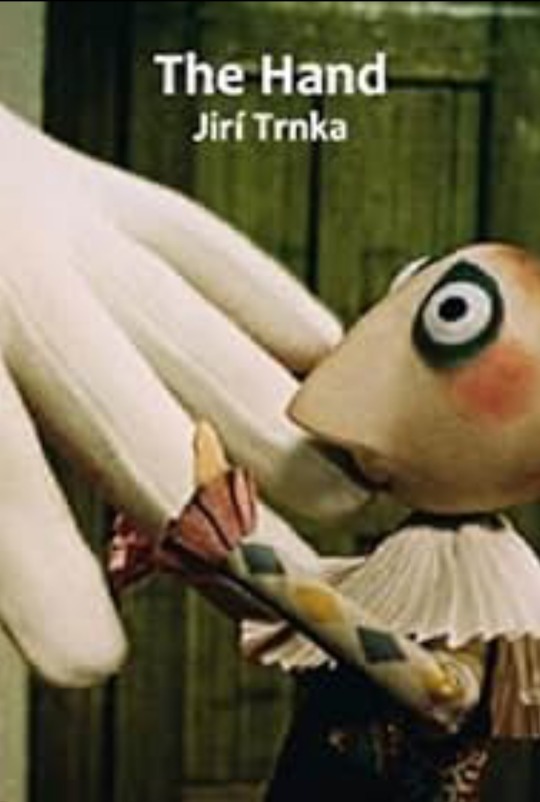
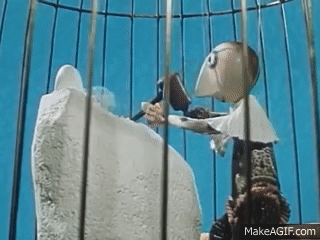

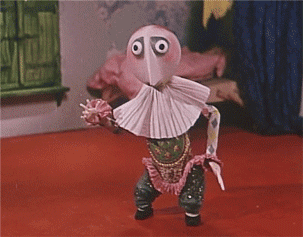
The story of this stop motion short is transparently the story of its context. A Czechoslovakian film made in 1965, the machine dominating eastern Europe was at full force, but running on fumes. Telling the story of a powerless sculpting jester having to survive the whims of the divine hand that torments him, this is also the story of the small common artisan in eastern Europe, being haunted towards the creation of propaganda for their government.
To call this film influential or acclaimed is a double understatement. Months after the creator's death (with this being his swan song), the film was banned in Czechoslovaquia, cited as improper messaging about what it was like to be an artist in the country. As for its critical reception, it takes a comfortable seat among many lists designating it as one of the most important animated shorts in the modern industry's history, influencing many artists of future generations, a notably outspoken one being Rebecca Sugar of Adventure Time and Steven Universe fame.
The fact that the short has been perserved is a miracle, as many of its peer productions are now considered lost media. This fact makes it to me the best example of the era's animated offerings, opening the gates for many artists of upcoming generations to get into experimental grooves in the psychedelic, surrealist and postmodern productions of the decades that followed it.
References:
Reviews, The Hand - IMDB
Political oppression and resistance in Jiří Trnka’s Ruka/The Hand (1965) - Fantasy Animation
The Hand (1965 film) - Wikipedia
1 note
·
View note
Text
Rooty Toot Toot (Columbia/UPA, John Hubley, Art Babbitt, 1951)
The 1950s was a pivotal decade for the industry. Disney was going all in on the parks, deeply unsettled by the war and demoralized by the strike, his rug was being pulled from under his feet. This isn't to say that Disney Studios was struggling, far from it, as they were releasing some (for the first time in many years) successful feature films, and settling in as even more of a household name. This, however, led to a lot of former Disney big names to feel a bit stifled by the direction the studio was headed in. Family entertainment could only go so far for many, and the styles in which they could work were limited to a mostly standardized "American cartoon" set of Art Nouveau guidelines, which, while beautiful, were definitely far from creatively encouraging.
This led to many important Disney animators leaving ourselves, and coming together to form what came to be called the UPA (United Productions of America) studio group, a production house led almost entirely by animators who revolutionized what cartooning could be. Abstract and impressionistic, their animated shorts were aimed at a general-but-adult audience, similarly to the early 1930s Disney shorts (though with the racism dialed way down). Death, infidelity, crime and violence were often what the films centered on, and black humor and esotericism were the genres of choice. This leads us to the film I'd like to highlight today:
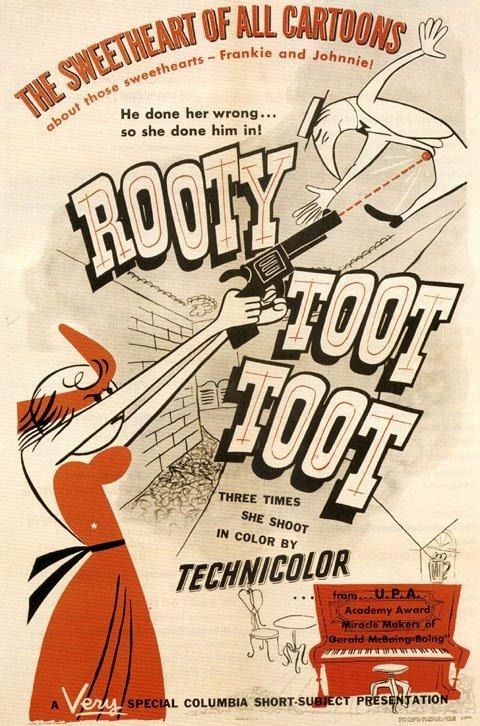

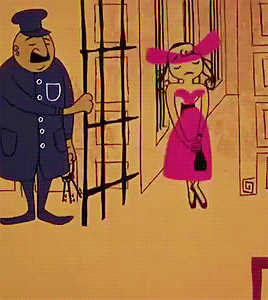
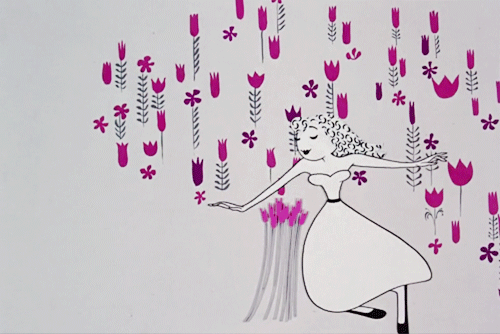
Rooty Toot Toot is a 7 minute Noir black comedy that tells of the trial of Frankie, accused perpetrator of the murder of her sweetheart Johnny, shot by 3 bullets to the chest. The prosecutor tells the story, Johnny was meeting with singer Nelly Bly for rehearsals at the local bar, and, out of jealousy, his scorned lover shot him as soon as she found out. The singer and the bartender give witness accounts, and then Frankie is represented. After her defense attorney spins the story on its head, the court deems her to be innocent, and she is released. Or, she would have been, had her defense attorney not kissed Nelly Bly at the courthouse, and caused Frankie to shoot him the same way with the evidence-gun right then and there.
A simple story, this short is eye opening for the time (and yet has aged like wine), and is much, much more than the sum of its parts. Set to a bebop tune, the short often rhymes and dances around itself in the most charming of ways. In fact, most of the character movements are presented as dances, and all of the character voices are fully in song to the music. A renowned milestone for the industry, the short was nominated for an Academy Award on release, and has been deemed to be in the top 50 most influential cartoons of all time.
This film stands out, as UPA was a house of much star power balanced out by puny amounts of funding. Mostly filled by embittered-yet-passionate ex-disneys and arthouse commies, it was hard for the artists to even afford the paper they shot, let alone aim for the success that they obtained through their cleverness, resourceful style and genius settings and stories. They should stand ad proof for any animator that ideas are king, and your skulls and resources should be honed for the service of the stories you want to tell if you aim to create the worlds you dream about.
I obviously find UPA to be incredibly inspiring, and I'm very happy to get to talk about them here, so this post was a treat to write. Happy Halloween!
References:
Rooty Toot Toot, Wikipedia:
The 70th anniversary of Rooty Toot Toot, Cartoon Research:
Rooty Toot Toot ~ John Hubley ~ UPA ~ 1951 ~ nice copy, justjeff53, YouTube
youtube
0 notes
Text
Working with Walt: interviews by Don Peri, 2008.
For something a bit different, this post will be taking a look at two interviews present in the book Working with Walt, which tackles the challenging wall of showcasing several points of view from the very people who worked in the same rooms as the controversial figure across many decades. Though I have only selected 2 of them, the book itself accounts for over a dozen perspectives, making it an essential read for anyone interested in the life of one of the most important people in film history.
Eric Larson (1905-1988)
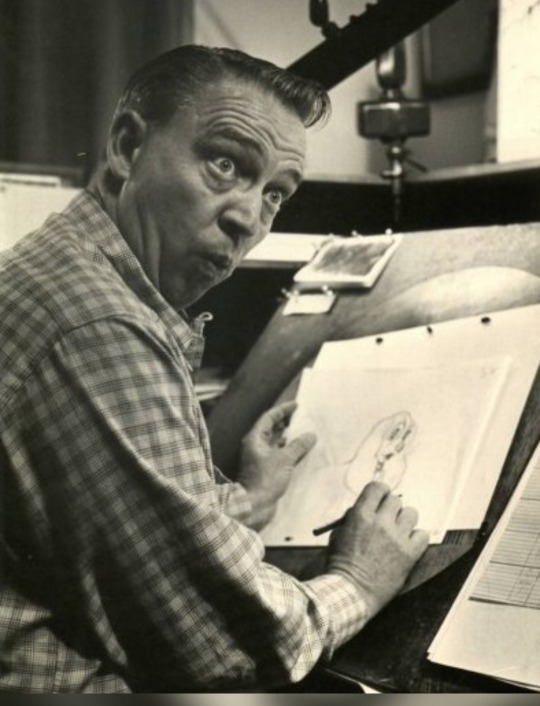

One of Disney's Nine Old Men, Larson is a bit of a legend in the industry. Working in the mouse house for a bit over 53 years, his is the longest run the studio has seen to date, and it showed. Establishing himself as a key piece in Disney's early filmography, he quickly rose through the ranks and became a supervisor around the early 40's, working in Snow White and directing and supervising Pinoccio, Fantasia and Bambi, as well as having a hand in almost every golden age Disney movie you could think of.
However, this is not the only reason he interested me specifically. This was actually his keen interest in nurturing the industry he so loved by heavily contributing to the formation and upkeep of Disney's Talent Program, which has to this day served as a beacon of training for some of film's most acclaimed names, such as Brad Bird, Glenn Keane, Henry Selick, Tim Burton, Ron Clements, Don Bluth, and many, MANY others (seriously, this program is kind of crazy if you look into it).
What's most impressive, Larson didn't even go into his career with the intent of participating in film. A radio enthusiast, he went into a local station to share a script, hoping to present it for a short serial, where he was pointed in the direction of Disney studios by coincidence, and offered a position he accepted with the most reluctance. To think people give themselves out nowadays for a fraction of the presence afforded to animators of the past, it can be a discouraging thought. However, it's also a bit of a grounder, to think it's mostly a right place-right time combination with one's skill, and that you can only do so much to control that.
Larson was also known for his enthusiastic approach, which is quite the feat for someone with such discipline, and the body of work to prove the success of his ways. Overall, definitely someone deserving of his awarded Disney Legend status.
Clarence Nash (1904-1985)

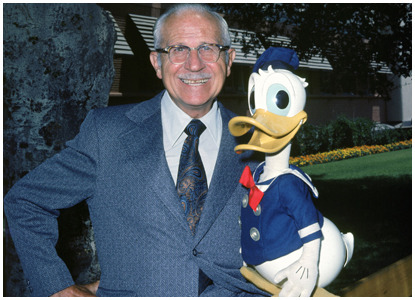
Clarence Nash needs very little introduction. Famed for his acting and impression work, the voice of Donald Duck made quick work of his industry, working in impression radio from his early 20s and being asked by Disney himself to informally audition for him, as he'd been impressed by his vocal chops in the radio show Merrymakers, where he'd worked for years. He was part of the studio as an instant match, and became the iconic voice actor for Donald from the second it was possible, holding this role for as long as he lived, with his last role being for Mickey's Christmas Carol in 1983, having done over 120 productions for this role and others.
I think it's impossible not to have a sort of connection with Nash's work, as someone interested at all in animation. Even those of us without the Disney itch have been raised in Donald Duck's world, and his voice is one of the most important pieces of performance the film industry has ever seen, easily, to this day.
It is said Nash was a bit of a cartoon character himself, with a piked interested in everything, everyone and anyone around him, at all times, with great zest for life and all of what it brought. It is hard to say he wasn't just method acting his whole life, naturally, and his story is one that reminds me of the value of earnest interest. As someone who often struggles being taken seriously because of a bouncey, easygoing demeanor, it is quite heartwarming to hear someone like him finding such a place in the world I want to call home.
References:
Working with Walt (2008), Don Peri:
Eric Larson - Wikipedia
Eric Larson - D23
9. Eric Larson - 50mostinfluentialanimators
Clarence Nash, Wikipedia
How Clarence Nash became Donald Duck - Cartoon Research
0 notes
Text
Puss Gets the Boot (Metro-Goldwyn-Mayer/William Hanna & Joseph Barbera, 1940)
As the war raged behind the scenes, the American (and honestly, worldwide) public was seeing the boom of Hollywood fully embracing animation for its own merit. Studios were solidifying, production houses were being established, and they were seeing a kind of once in a generation success that had not (and still isn't) easy to come by. A good part of this can be fully attributed to the desire by audiences to look for humorous escapism to lure them out and away from the dread of warfare surrounding the world during this era. This is the environment in which this short film is born.
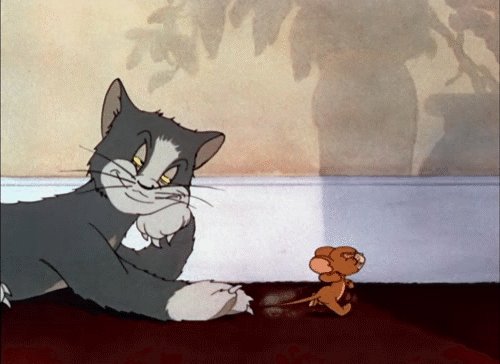
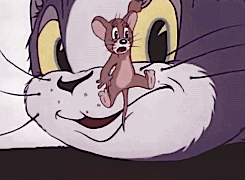

Puss Gets the Boot is a 7 minute Technicolor blast, nothing but nonstop rapid-fire slapstick in which the characters, not yet Tom and not yet Jerry, one-up eachother to find who can come out on top. This under the set up that, if the cat, who's currently going by Jasper, makes one more mess in the house, he'll be getting the literal and metaphorical boot. The short plays as one would expect, but goes pretty hard in the paint in its humor, being darker than one would think and just teetering in the borderline of still being considered Family Entertainment.
On this initial premise, the studio executives were... not exactly thrilled. They were said to have found it dull, slapstick for the sake of it, and not quite a picture with much to say behind the gags. However, audiences could not have disagreed more: it was a blowout success. What's more, it instantly turned its main characters into household figures, and was even nominated for an academy award.
Needless to say, of course Tom&Jerry was a success out the gate. The premise writes itself, and is elevated by masterful animation on top of creative setups that are there from even their first short. It pushed just enough boundaries to surprise and amaze, but stayed within the popular conception of the time just enough, being based on an Aesop Fable, to still be easily understood and enjoyed by the American moviegoers of the time.
However, as is (unfortunately, but predictably) becoming a trend in these shorts, there is, once again, racism. The premise of Jasper being booted from the house is shared with the audience by the house's maid, a pretty obvious Mammy stereotype, who looks, sounds and plays into the trope for the entertainment of the audience. Yes, this was the reality of the time, if you are to see a maid in the 1940s, chances are she is going to be a black woman, and if you are to see a black woman in a 1940s-made film, chances are she will be a servant of some kind, as that was the law of the land at this time. But even with this in mind, it is important to notice how much of animation is based on borrowing from minstrelsy and obvious racist caricatures, especially of black and Asian people, and how this has an effect on how the audience, then and now, interacts with this now historical pieces of our industry, that which we claim to love.
References:
Puss Gets the Boot, Wikipedia:
Puss Gets the Boot and Midnight Snack, YouTube:
youtube
Puss Gets the Boot - Tom & Jerry, SUPERCARTOONS:
0 notes
Text
Funny Little Bunnies (Wilfred Jackson, Walt Disney Pictures, 1934)
For some general context: as we approach current day, a trend will show, this being that the existing industry of the time will begin to resemble current day film incrementally over time. Of course, this wasn't a smooth one-to-two process, there were many phases through which the industry went through over several decades, but this is a good thought to keep as a rule of thumb going forward.
The time we're going to talk about today was no different. In fact, the 1930s mark a stark contrast to what came before in this regard. Production studios began to make waves and become increasingly relevant, and they, along with general public conceptions of what film was and could be, shaped what was once thought as a silly gimmick into one of the most prosperous industries in the world, and one of the main go-to standout cultural advancements of the century.
Having set the stage, where to go from here. We have a film industry now, and animation is growing along with it. Disney has formed into a proper production house, almost entirely animation-based, and has made quite the name for itself, winning several Academy Awards (oh yeah, those exist now too) and turning into a household name. How have they done so? Well, by pushing out as many Silly Symphonies as they could. A good example of this, and what I'll be taking a look at today, Funny Little Bunnies!
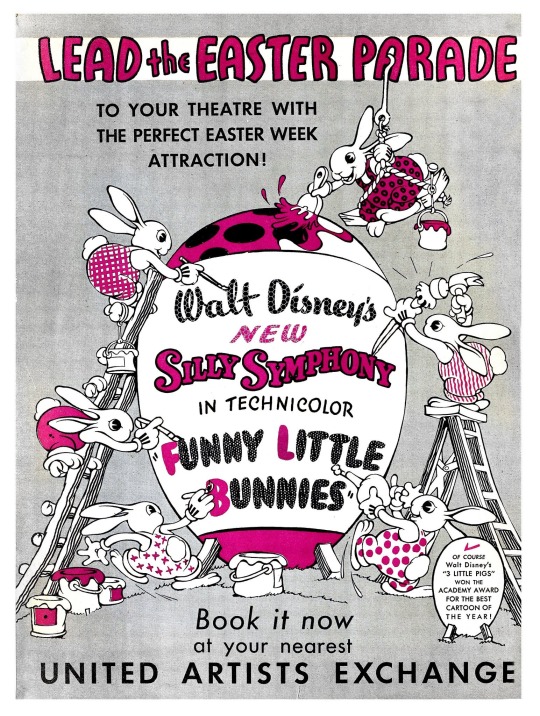



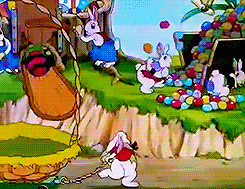
This might be just about the most standard Silly Symphony one could think of. As usual, not much for story, the short is about Easter Bunnies preparing painted eggs for Easter Egg Hunting. That's about it. However, this little ditty is just exactly that, and takes that simple premise in stride. Calling the difference in visuals a leap from those of just a few years ago would be an understatement, as the fully Technicolor wonder (not the first, but quite the vibrant early example of the early two-tone version of the tech) just chews its own scenery, and makes it look easy. This short might be on the sillier end of the Silly Symphonies, but it's honestly outstanding how well the animation holds up for one of Disney's first full color productions. Not really trying as hard to be comedic as it's contemporaries, it's just whimsical and bizarre watching this extended musical sequence, and it's one I have quite the personal history with, having grown up watching it.
Shot in cels with an early multiplane camera, it runs pretty much just as well as any Disney feature would through the rest of the century, and audiences loved it. While not as renowned as its Piggy/Hare/Hen contemporaries, the short was still a general success with audiences, though its exact numbers go went unreported, and showcases a good general view of what kind of movies the Disney company would make a name for itself with. It also stands to mention that this was one of the first times the industry attempted a seasonally themed release, following the steps of its hallowed older siblings, though with less scares.
Overall, I think this is a very solid short, especially for younger (as in, YOUNG) audiences, that has a lot of charm. I think it's important to take looks at the features that didn't push, but set the boundaries, as it can be difficult to grasp the impact of the former when the latter goes unacknowledged, and I think this is a great example of that. Not every short can be a 10/10, and I don't think it should! Sometimes simple and clean viewings are necessary palate cleansers to really enjoy other, more mindblowing experiences.
Sources:
How was animation done at Disney in the 1930s?, Forbes.
Funny Little Bunnies, IMDB.
10 best silly Symphonies from Disney's Golden Era, Collider
Funny Little Bunnies; Silly Symphony, Wikipedia
0 notes
Text
Animation before the 1930s.
Let's begin with some context. While modern film can barely call itself a century old, animation as an art form is quite the dinosaur. From picture shows of the 17th century (picture being used quite literally) to theories about the use prehistoric early humans had for oddly formed cave paintings that react to angled light, making drawings move is a tradition humans have kept as a way to tribute the world around us for as long as we've existed. I however, will not exist for so long, and so I'd like to focus my efforts on a singular piece of art.
The Haunted House (Columbia Pictures, Ub Iwerks/Walt Disney, 1929)
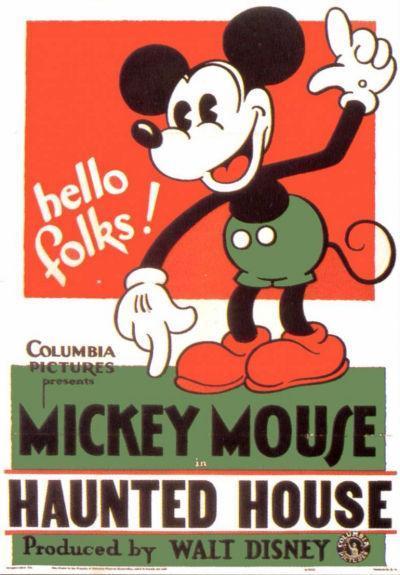

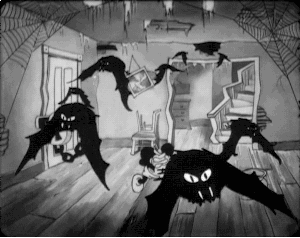

As the decade turned, animated shorts began their reign within the early movie theaters. Usually comedic, these irreverent pieces were used to satirize characters of contemporary society, from politicians and celebrities to the local everyman, and to great effect. As such, it wasn't long before the socially conscious genre, horror, intersected with these productions.
The Haunted House is a surreal horror-comedy musical that wears its mood on its sleeve. As with most early Disney productions, this short is a low-dialogue, lightly storied run that's centered by a prolonged musical number that runs through most of its length. With early-yet-biting, snappy animation, the charismatic folks dancing throughout make it hard not to get in a spooky, funky mood alongside. Skeletons, wraith and bats scare Mickey into becoming a virtuoso pianist in an abandoned old Gothic manor, and his incredible talent turns the place into nothing short of a booming jazz club, with a killer cut by Carl Stalling, a soon-to-be Warner Brothers superstar. Running on black and white celluloid reel, the short clocks in at almost 7 minutes including credits.
With this brief description behind, this short's ensuing reputation has grown to match its inherent content in relevance, as it has gone through quite the roller coaster. Received at the time with mixed reviews, ranging from gleamingly high to mundanely mediocre, it was ran quite successfully in the theater, gathering a reputation as the a short that made you go watch the would-be-main picture. However, from its launch, a particular gag in its first third was the object of severe scrutiny, as Mickey looks for help to escape the manor, and, out of options, calls out thrice for his Mammy. This now unanimously unfortunate line is a reference to a contemporary minstrel show of the time, in which racist-tirade-performer Al Jolson (who's own history is so bizarre that it could warrant its own discussion) does basically the same thing, almost verbatim. While at the time this gag was somewhat panned due to it being crass, inappropriate or just plain tacky; modern audiences see it more plainly as an unnecessary remark that dates the film, in many more ways than one. This did not go unnoticed by Disney, who, in re-releasing early works, preceeds the short with a short introduction tackling its history of utilizing racial stereotypes.
Alongside this complication, this short has taken in a bit of a reputation in recent decades, becoming a bit of a darling for online spooky culture and material, with the skeleton dance segments being the centers of attention. It is not uncommon, however, for most people online to not have even come across the source of these sections, or even knowing that they're from the same film, and, to be completely honest, I don't personally find there to be any issue with this. The film itself is not much more than a compiled mood, which can be replicated easily by the online edits of these short sections set to their own music, or as accessories to other content within this bubble. I don't say this to mean the short is bad or not worth a viewing, as I do find it somewhat quaint, but it's difficult history nails the coffin that is the fact that, well... it's old. There is not much for story, it's quite drawn out and most of the animation is far from the best one can find in the Silly Symphonies, as it's often just sets of reused loops played straight while moved across the screen to hide from scrutiny; and the sections that aren't the musical sequence are noticeably lower in quality.
Overall, this is a piece of work that I feel has been elevated from its own text over the years because of its online relevance. Trimming its fat, as well as most not even knowing of its racist sequence, has made its best parts stand out quite a lot, while also allowing the original short to be deservingly scrutinized, almost somewhat separately. However, that is just what I think, and as someone who is not black, I'm not one to say that is my call to make, just my mental two cents on something that can't go unmentioned while talking about this short film.
Happy October, stay spooked!
Sources:
Notes on the Origins of American Animation, Library of Congress.
The Haunted House, Wikipedia.
Al Jolson, Wikipedia.
https://en.m.wikipedia.org/wiki/Al_Jolson
Walt Disney's Mickey Mouse - The Hounted House (1929), Old Disney Shorts
https://youtu.be/ONDxQohHBGE?feature=shared
0 notes
Text
Animation throughout my life: a spotlight.
As someone who's giving their life into a career in animation, it shouldn't come as a surprise that I've had quite a history with the medium. Of course, as most, I grew up watching cartoons every day, and it'd be naive to think those childhood experiences haven't deeply shaped my thoughts on both the medium and art as a whole, as well as in life in general, as the emotional resonance and mood that animation can achieve are pretty much the main pieces that bind me to it as artistic impression. This being said, in my thinking for this post, I wanted to showcase works of art that have impacted me more recently, as a series of big and fast life changes have molded me into the person I am today, and I credit these pieces, among many others, for helping me hold everything together over my yet short stint in the field of adulthood. As per my usual, I've tried to spread myself evenly into one movie, one game and one show, for the sake of balance.
Song of the sea (Cartoon Saloon, 2014)
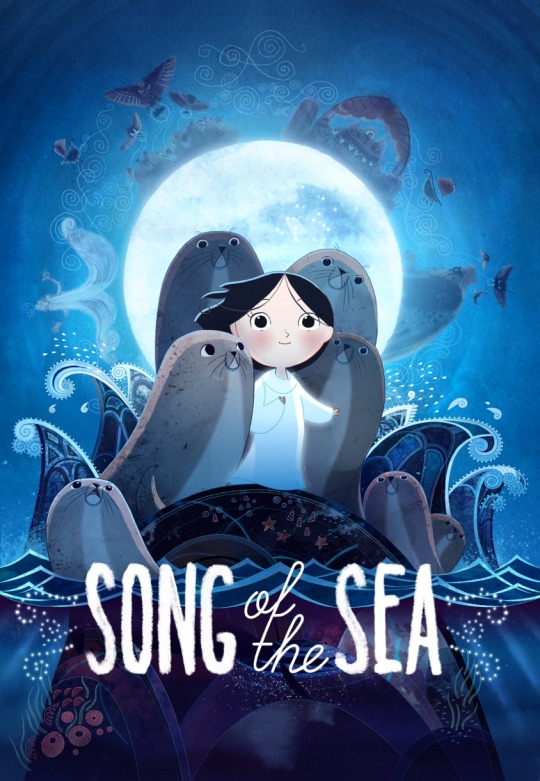


This masterwork film comes from a very small Irish animation collective, Cartoon Saloon, held up mostly by Irish government subsidies, as their works have garnered a bit of a reputation as preservation efforts for millenary pieces of traditional Celtic/Gaelic/Irish culture. This, however, is no edu-tainment snoozefest. The story of an older sibling coping with both the birth of a new sibling alongside a wave of loss is by no means a story never told. However, there is so much more here than what can be conveyed in an elevator pitch. Breathtaking animation that fits the emotional storytelling like a glove, a score that puts chills on chills and creative use of its setting form a piece of magical realism that moved me more than I can put to words. If you don't mind crying, give it a watch, I hope it gives you as much as it's given me.
Bee and Puppycat (Frederator/Cartoon Hangover, 2013)
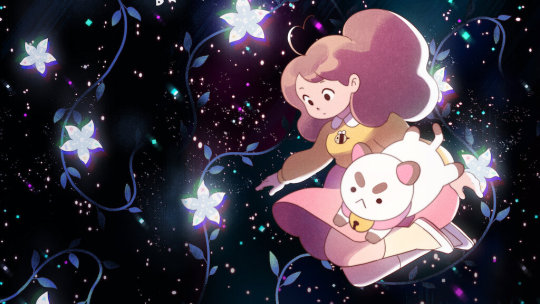
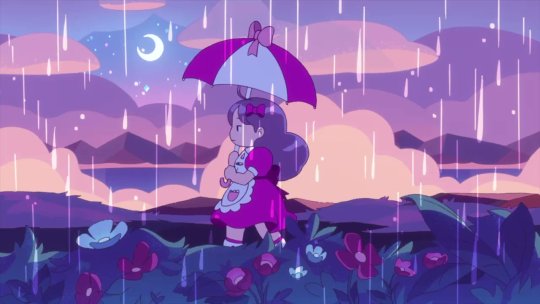
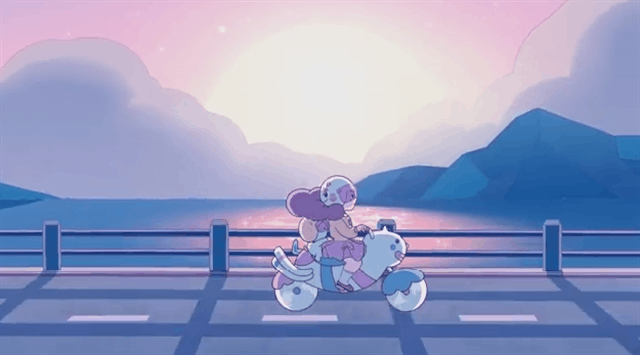

The history of this show isn't anything short of bizarre. Released originally as a bit of a proto-web-animated series on the YouTube channel Cartoon Hangover and later released on the Nintendo 3DS' Nintendo Video, this loosely connected, hour long show/special tells a story equally as... avant garde? (Is it pretentious to use that term on Tumblr?) as its odd release strategy. Bee, a young adult struggling to keep a job and bouncing from place to place, bumps into a strange creature that looks kind of like a cat and a dog, smelling like the latter and having the ability to speak. Over the course of the show, they go on monster-of-the-week style (4-7 minute long!) episodes, all surrounding Bee, her closest friends and her own astranged relationship with her origins and her humanity. What can often feel like a high budget meme of a show ends up turning into a series of emotional meteorite strikes that will not hesitate to put you under. Definitely one of the best things you can watch on a 3DS.
GRIS (Nomada Studio, 2018)
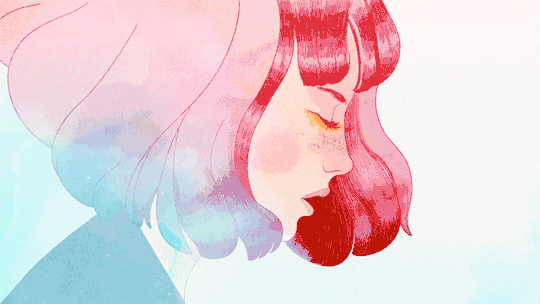

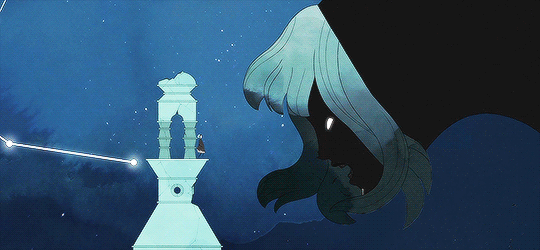
This game is a bit of a no-brainer for this trio. Emotionally resonant arthouse style indie productions with a cutting edge plot line deeply hitting into a gutpunch climax are, well, my favorite genre of... things, really, and this is no exception. Fully hand-watercolored, GRIS tells the story of a girl who has to come to terms with the loss of a loved one, vagueness fully intended. Over the course of the game, you begin to unravel more of the stark emotional reality of what this loss has meant to the protagonist, and how difficult it can be to cope, as what brought solace has become dim, if not fully unattainable. This game has no dialogue, none of the characters have names and is a rather simple one-sitting puzzle platformer. On top of having one of the most touching plots in games I've ever played, this is a piece of art that knows what it is, recognizes it's limits and fully embraces them, utilizing it all to its major advantage.
Overall, while far from comprehensive, these are some of the pieces that have made a deep impact on me and have helped me understand both what I enjoy and what I personally aim to strive for in my artistic pursuits, and the past few years have been quite rich in both quantity and quality for me in that regard.
0 notes
